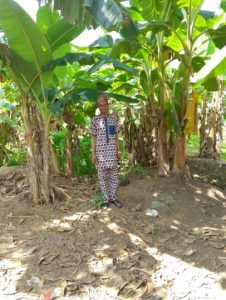
Like any other venture aimed at success, plantain farming that guarantees profitability requires observing the following procedures.
According to the political scientist turned farmer Thomas Adekunle Oyewole whose farm is located at the Government Reserve Farm Settlement 111, Ayedaade Local Government, Osun State, the steps involved in raising successful plantain farming are as follows:
1. Location of land with substantial loamy soil content.
2. The second step is to clear the land, preferably manually with the cutlass. Ploughing with a tractor should be avoided because plantain farming requires shrubs and some other grown crops to serve as protection during the dry season and also protect the soil against direct sunlight which erodes soil fertility over time. A published report by the International Institute of Tropical Agriculture (IITA) adds that “trees must be cut but the stumps are not to be removed, and the trees should be left to grow again. They can be pruned only when they start to obstruct field activities or shade the plantains.”
Processes involved in successful plantain farming
Some small tree plants are allowed to grow with the plantains for protection
3. The third step is hole digging which can be done with the aid of a machine or manually through the use of a cutlass or any other suitable hand tool. The farmer must ensure that such holes are deep enough to enable the suckers to have a long life. The IITA report recommends a minimum size of about 30 cm x 30 cm x 30 cm.
4. Next step is planting of the suckers. Plantain can be planted with other arable crops such as cocoa, oil palm, cassava, maize, and so on. Oyewole who is also a poultry farmer planted cocoa, oil palm, maize and cassava on his plantain farm. He revealed that he did not set out to farm plantain but planted the crop as a means of protection for his then-young cocoa trees. The plantains, he disclosed, became the crop that started fetching him his first revenue from the farm before the cocoa plantation began production of seeds.
10 reasons plantain farming is highly profitable
Plantain suckers
5. Another important aspect is spacing. According to the IITA report, “the recommended spacing is 3 m between the plantain rows and 2 m within the row (in other words. 3 m x 2 m). An alternative is 2.5 m x 2.5 m. If spaced 3 m x 2 m, 1 hectare should contain 1667 plants, but with a spacing of 2.5 m x 2.5 m, it should contain 1600 plants. Rows should be straight in flat fields to give plants the maximum amount of sunlight. However, on sloping land, rows should follow the contour lines to decrease soil erosion.”
6. Choosing the time to plant. The IITA report explains thus: “Plantains can be planted throughout the rainy season. However, they should grow vigorously and without stress during the first 3 to 4 months after planting, and therefore they should not be planted during the last months of the rainy season. Planting with the first rains seems agronomically sound but not financially advantageous. Most farmers will plant at the onset of the rains, causing the market to be flooded with bunches 9 to 12 months after planting when prices will be very low. Planting in the middle of the rainy season is a better proposition as plantains will then be produced off-season and get high prices.
10 reasons plantain farming is highly profitable
What is the capital outlay to profitably raise a plantain farm? Oyewole, who boasts of over twelve years of plantain and cocoa farming experience, said answer to the question would depend on many factors.
Processes involved in successful plantain farming
Shrubs and some other trees can be seen on the farm providing mulching and shade for the young plantain trees. Photo via Google
According to him, the location and size of the farm will determine the cost of land, suckers, labour, the varieties of other crops and the distance between the farm and the town.
Are there challenges that could put paid to successful plantain farming? The answer is a YES.
To Oyewole, “the challenges are numerous”.
He listed them to include the cost of purchasing land; accessibility to virgin land suitable for plantain farming; deadly activities of nomadic Fulani herdsmen; cost of marketing, and theft on the farm.
Other challenges, according to him, include the adverse effects of climate change; lack of access to low-interest loans; youths’ lack of interest in farming; a dearth of infrastructure in rural areas; improper budgeting; pests and diseases, among others.
isaisawade74@gmail.com
 DailyrecordNg …Nigeria's hottest news blog
DailyrecordNg …Nigeria's hottest news blog








